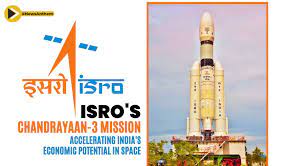Chandrayaan-3 Mission: A Catalyst for Economic Growth in India's Space Sector

The Indian Space Research Organization (ISRO) is set to launch its highly anticipated Chandrayaan-3 mission on July 14. This lunar exploration endeavor not only holds immense scientific significance but also carries the potential to propel the Indian economy forward. In this article, we explore the economic benefits that the successful Chandrayaan-3 mission can bring to India's space sector, attracting investments, creating job opportunities, and positioning India as a major player in the global space race.
Investment Boost in Space Technology:
Chandrayaan-3's successful launch is anticipated to increase investor confidence and spur further private investment in space technologies. With India poised to become the fourth country to achieve a successful lunar landing, it validates the country's capability in supplying cost-efficient and reliable space-grade hardware. This validation, combined with the increasing investments in the space industry globally, opens doors for greater foreign investments in India's space-tech startups and businesses.
Impact on Space Start-ups and Job Creation:
The growth of India's space-tech ecosystem has already generated thousands of jobs, and Chandrayaan-3 is set to further accelerate this trend. The mission's success will create high-tech job opportunities in science and engineering, contributing to India's strategic asset in terms of knowledge and expertise. With more moon missions on the horizon, both government and private lunar programs are expected to generate several thousand direct and indirect jobs, fostering economic growth and innovation.
Commercial Opportunities for Indian Companies and Startups:
Chandrayaan-3's triumph will not only boost India's standing in the space league but also open up commercial opportunities for Indian companies and startups in the space sector. The mission serves as a technology demonstrator, showcasing India's capabilities to design and manufacture space systems and subsystems for global markets. This increased goodwill and expertise can attract joint ventures and collaborations, enabling Indian entities to develop and offer products and services in the global space industry.
Enhanced Global Positioning:
The successful Chandrayaan-3 mission would position India among the top four technologically advanced space nations, further strengthening its global standing. India's space achievements can attract more investments, taking advantage of cost efficiency and the abundance of high-tech skills available in the country. Furthermore, successful international collaborations, such as the recent Artemis Accord with NASA, exemplify India's potential to become a significant player in the global space race.
Conclusion:
As India prepares for the launch of Chandrayaan-3, the significance of this mission extends beyond scientific exploration. The economic benefits it holds for India's space sector are substantial, including increased private investments, job creation, and improved global positioning. With a successful mission, India's space industry will gain momentum, fostering innovation, technological advancements, and contributing to the country's overall economic growth. As all eyes turn towards the moon on July 14, the potential impact of Chandrayaan-3 on India's economy is eagerly anticipated.
